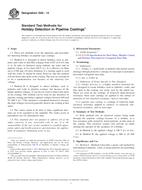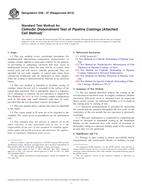Potřebujeme váš souhlas k využití jednotlivých dat, aby se vám mimo jiné mohly ukazovat informace týkající se vašich zájmů. Souhlas udělíte kliknutím na tlačítko „OK“.
ASTM G189-07(2013)
Standard Guide for Laboratory Simulation of Corrosion Under Insulation
Automaticky přeložený název:
Standardní Guide pro laboratorní simulaci koroze pod izolací
NORMA vydána dne 1.8.2013
Informace o normě:
Označení normy: ASTM G189-07(2013)
Poznámka: NEPLATNÁ
Datum vydání normy: 1.8.2013
Kód zboží: NS-57567
Počet stran: 12
Přibližná hmotnost: 36 g (0.08 liber)
Země: Americká technická norma
Kategorie: Technické normy ASTM
Kategorie - podobné normy:
Anotace textu normy ASTM G189-07(2013) :
Keywords:
corrosion under insulation, CUI, electrochemistry, mass loss, polarization resistance, protection efficiency, thermal insulation, ICS Number Code 23.040.99 (Other pipeline components)
Doplňující informace
| Significance and Use | ||||||||||||||||||||||||
|
5.1 The corrosion observed on steel and other materials under thermal insulation is of great concern for many industries including chemical processing, petroleum refining and electric power generation. In most cases, insulation is utilized on piping and vessels to maintain the temperatures of the operating systems for process stabilization and energy conservation. However, these situations can also provide the prerequisites for the occurrence of general or localized corrosion, or both, and in stainless steels, stress corrosion cracking. For example, combined with elevated temperatures, CUI can sometimes result in aqueous corrosion rates for steel that are greater than those found in conventional immersion tests conducted in either open or closed systems (see 5.2 This guide provides a technical basis for laboratory simulation of many of the manifestations of CUI. This is an area where there has been a need for better simulation techniques, but until recently, has eluded many investigators. Much of the available experimental data is based on field and in-plant measurements of remaining wall thickness. Laboratory studies have generally been limited to simple immersion tests for the corrosivity of leachants from thermal insulation on corrosion coupons using techniques similar to those given in Practice G31. The field and inplant tests give an indication of corrosion after the fact and can not be easily utilized for experimental purposes. The use of coupons in laboratory immersion tests can give a general indication of corrosion tendencies. However, in some cases, these procedures are useful in ranking insulative materials in terms of their tendencies to leach corrosive species. However, this immersion technique does not always present an accurate representation of the actual CUI tendencies experienced in the service due to differences in exposure geometry, temperature, cyclic temperatures, or wet/dry conditions in the plant and field environments. 5.3 One of the special aspects of the apparatus and methodologies contained herein are their capabilities to accommodate several aspects critical to successful simulation of the CUI exposure condition. These are: (1) an idealized annular geometry between piping and surrounding thermal insulation, 5.4 With the CUI-Cell, the pipe material, insulation and environment can be selected for the desired simulation needed. Therefore, no single standard exposure condition can be defined. The guide is designed to assist in the laboratory simulation of (1) the influence of different insulation materials on CUI that, in some cases, may contain materials or additives, or both, that can accelerate corrosion, (2) the effect of applied or otherwise incorporated inhibitors or protective coatings on reducing the extent and severity of CUI. This guide provides information on CUI in a relatively short time (approximately 72 h) as well as providing a means of assessing variation of corrosion rate with time and environmental conditions. |
||||||||||||||||||||||||
| 1. Scope | ||||||||||||||||||||||||
|
1.1 This guide covers the simulation of corrosion under insulation (CUI), including both general and localized attack, on insulated specimens cut from pipe sections exposed to a corrosive environment usually at elevated temperature. It describes a CUI exposure apparatus (hereinafter referred to as a CUI-Cell), preparation of specimens, simulation procedures for isothermal or cyclic temperature, or both, and wet/dry conditions, which are parameters that need to be monitored during the simulation and the classification of simulation type. 1.2 The application of this guide is broad and can incorporate a range of materials, environments and conditions that are beyond the scope of a single test method. The apparatus and procedures contained herein are principally directed at establishing acceptable procedures for CUI simulation for the purposes of evaluating the corrosivity of CUI environments on carbon and low alloy pipe steels, and may possibly be applicable to other materials as well. However, the same or similar procedures can also be utilized for the evaluation of (1) CUI on other metals or alloys, (2) anti-corrosive treatments on metal surfaces, and (3) the potential contribution of thermal insulation and its constituents on CUI. The only requirements are that they can be machined, formed or incorporated into the CUI-Cell pipe configuration as described herein. 1.3 The values stated in inch-pound units are to be regarded as standard. The values given in parentheses are mathematical conversions to SI units that are provided for information only and are not considered standard. 1.4 This standard does not purport to address all of the safety concerns, if any, associated with its use. It is the responsibility of the user of this standard to establish appropriate safety and health practices and determine the applicability of regulatory limitations prior to use. |
||||||||||||||||||||||||
| 2. Referenced Documents | ||||||||||||||||||||||||
|
Podobné normy:
Historická
15.12.2011
Historická
1.4.2012
Historická
1.6.2013
Historická
1.7.2014
Historická
1.12.2010
Historická
1.6.2013
Doporučujeme:
Aktualizace technických norem
Chcete mít jistotu, že používáte pouze platné technické normy?
Nabízíme Vám řešení, které Vám zajistí měsíční přehled o aktuálnosti norem, které používáte.
Chcete vědět více informací? Podívejte se na tuto stránku.



 ASTM F2599-11
ASTM F2599-11 ASTM F2831-12
ASTM F2831-12 ASTM G55-07(2013)..
ASTM G55-07(2013).. ASTM G62-14
ASTM G62-14 ASTM G8-96(2010)..
ASTM G8-96(2010).. ASTM G95-07(2013)..
ASTM G95-07(2013)..
 Cookies
Cookies
